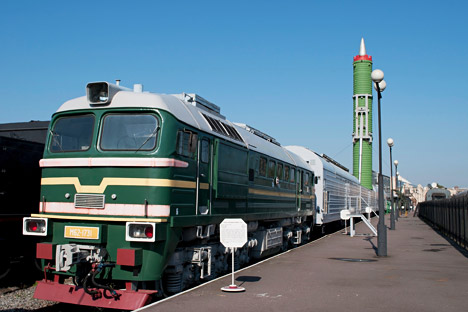Russia to overhaul its nuclear missile shield

Russia is eyeing rail-mobile ballistic missile systems. Pictured: The "Molodets" rail-mobile ballistic missile system. Source: Lori / Legion Media
According to Vladimir Komoyedov, head of the State Duma’s defense committee, spending on nuclear weapons will reach just over 100 billion rubles ($3.1 billion) in 2013–2015, compared to just 27.4 billion rubles in 2012. Nuclear missile forces will benefit the most from the projected increase in budget allocations.
Related:
Reports on Russian submarine off the U.S. coast fuel tensions
U.S. chops military deals with Russia
The chairman of Russia’s Ministry of Defense Public Council and editor-in-chief of Natsionalnaya oborona (“National Defense”) magazine, Igor Korotchenko, sees the increase in spending as a natural phenomenon.
“This is the objective reality,” he said. “It reflects the essence of the current and foreseeable global political situation. And, if Russia wants to protect its national interests, then it has to respond to this.”
The former head of the Ministry of Defense’s international military cooperation department, Lt.-Gen. Yevgeny Buzhinsky, notes that the rise of financing for national defense is a direct result of the financing gap of the 1990s.
“The failure to adequately build up the armed forces must be made up for in order for the country not to lag behind the global leaders,” Buzhinsky said.
Korotchenko specifically attributes the increase in budget allocations for the nuclear weapons complex to the impending mass production of new types of solid-fuel ballistic missiles – the Bulava and RS-24 Yars.
“They are essential to our armed forces, given the plans to discard and decommission a substantial part of our strategic delivery weapons, those with an expired service life that need to be replaced,” Korotchenko said.
In early September, the commanders of the Strategic Rocket Forces, Col. Gen. Sergey Karakayev, said that Russia would create a new heavy intercontinental ballistic missile with a carrying capacity of five tons – four times the capacity of the Yars or Topol. In early October, the Russian Ministry of Defense approved the design for a new liquid-fuel intercontinental ballistic missile for the Strategic Rocket Forces.
Commenting on the time frame for the creation of the missile, deputy director general of the Military Industrial Corporation NPO Mashinostroyeniya, Andrei Goryaev, said that roughly ten years would be required.
“Following a 30-year break, the country might encounter difficulties at various phases that cannot be anticipated,” he said.
A submarine nuclear-shield component is also being developed. The Borei-class Yuriy Dolgorukiy submarine of Project 955 is expected to be put into service in 2013, whereas the first Alexander Nevsky nuclear ballistic missile carrier of the same class and project will become part of the Pacific Fleet in 2014, said Defense Minister Anatoliy Serdyukov.
Rail-mobile ballistic missile systems
Rail-mobile ballistic missile systems are trains with two or three locomotives and special carriages (resembling refrigerator or passenger carriages) that carry transport and launch containers with intercontinental ballistic missiles.
Owing to its mobility and deployment capacity, the rail-mobile ballistic missile system ensures that the location of missiles remains unknown. The system has a high survival capacity, even in the event of a nuclear war. The last Russian rail-mobile ballistic missile system was removed from combat duty in 2003, as part of the 1993 Strategic Arms Reduction Treaty (START) II with the United States.
Furthermore, Col. Vadim Koval, the Russian Ministry of Defense’s spokesperson for the Strategic Rocket Forces, said that Russia was eyeing rail-mobile ballistic missile systems. However, the “final decision on the complexes has not yet been made,” Koval was quoted as saying.
Obviously, nuclear missiles are not designed for local conflicts, but to maintain the balance of power in the geopolitical confrontation with the United States. The development of America’s global missile defense system and the implementation of the Prompt Global Strike effort have encouraged the Russian Armed Forces to seek an asymmetrical response to these challenges.
When running for the presidency back in February 2012, Vladimir Putin made this clear in his article for Rossiyskaya Gazeta “Being strong: National security guarantees for Russia”.
Commenting on the challenge from the U.S. missile defense system, Putin promised that “Russia’s military response to the global U.S. missile shield, including its European part, will be effective and asymmetrical – a match for U.S. missile defense policy.”
He went on to say that Russia would “under no circumstances” give up its strategic deterrent capability.
The new role of Russian nuclear weapons is best described as such: they exist both to ensure strategic missile and nuclear parity and to rule out the use of nuclear weapons, by way of creating a framework under which neither party will have advantages in countering a nuclear attack.
All rights reserved by Rossiyskaya Gazeta.
Subscribe
to our newsletter!
Get the week's best stories straight to your inbox